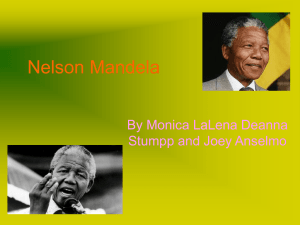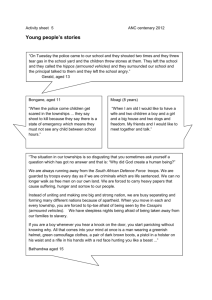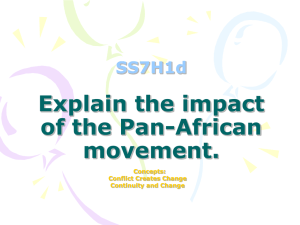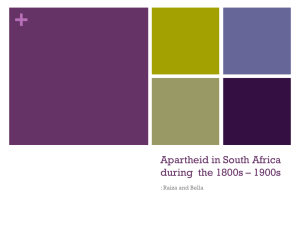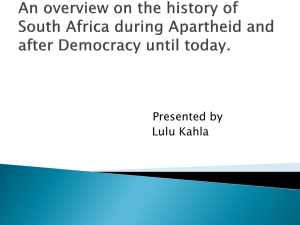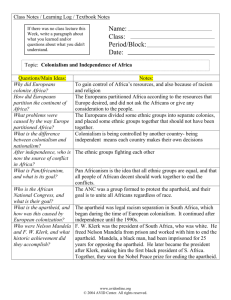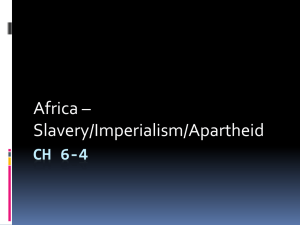Summary of Apartheid - Newton Public Schools
advertisement
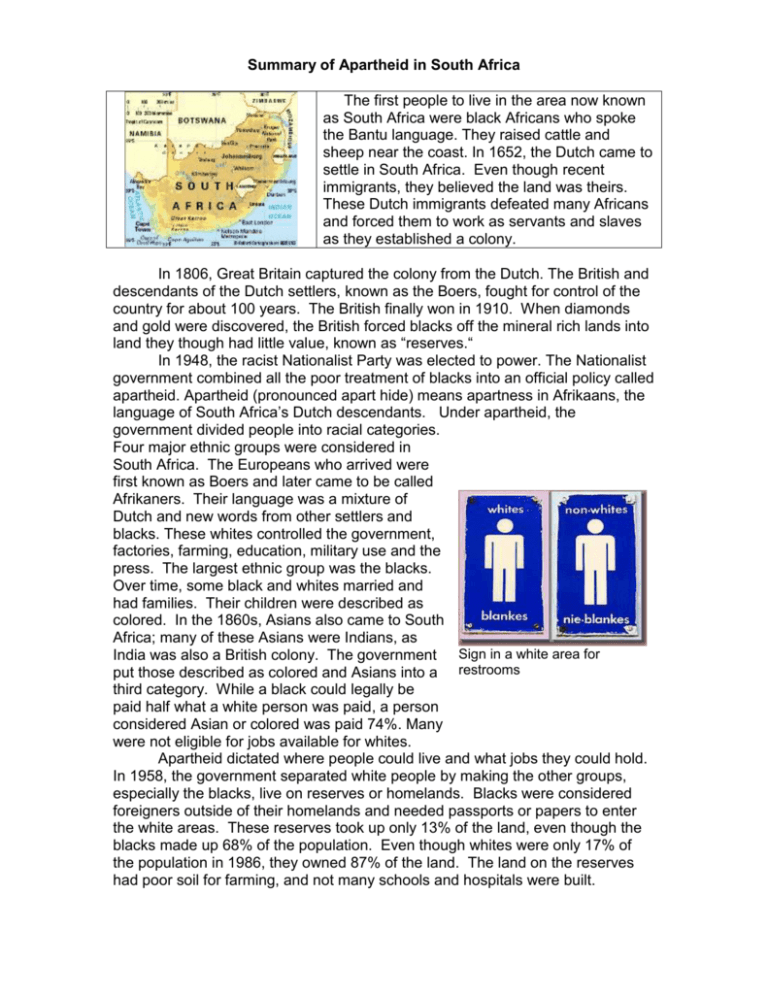
Summary of Apartheid in South Africa The first people to live in the area now known as South Africa were black Africans who spoke the Bantu language. They raised cattle and sheep near the coast. In 1652, the Dutch came to settle in South Africa. Even though recent immigrants, they believed the land was theirs. These Dutch immigrants defeated many Africans and forced them to work as servants and slaves as they established a colony. In 1806, Great Britain captured the colony from the Dutch. The British and descendants of the Dutch settlers, known as the Boers, fought for control of the country for about 100 years. The British finally won in 1910. When diamonds and gold were discovered, the British forced blacks off the mineral rich lands into land they though had little value, known as “reserves.“ In 1948, the racist Nationalist Party was elected to power. The Nationalist government combined all the poor treatment of blacks into an official policy called apartheid. Apartheid (pronounced apart hide) means apartness in Afrikaans, the language of South Africa’s Dutch descendants. Under apartheid, the government divided people into racial categories. Four major ethnic groups were considered in South Africa. The Europeans who arrived were first known as Boers and later came to be called Afrikaners. Their language was a mixture of Dutch and new words from other settlers and blacks. These whites controlled the government, factories, farming, education, military use and the press. The largest ethnic group was the blacks. Over time, some black and whites married and had families. Their children were described as colored. In the 1860s, Asians also came to South Africa; many of these Asians were Indians, as India was also a British colony. The government Sign in a white area for put those described as colored and Asians into a restrooms third category. While a black could legally be paid half what a white person was paid, a person considered Asian or colored was paid 74%. Many were not eligible for jobs available for whites. Apartheid dictated where people could live and what jobs they could hold. In 1958, the government separated white people by making the other groups, especially the blacks, live on reserves or homelands. Blacks were considered foreigners outside of their homelands and needed passports or papers to enter the white areas. These reserves took up only 13% of the land, even though the blacks made up 68% of the population. Even though whites were only 17% of the population in 1986, they owned 87% of the land. The land on the reserves had poor soil for farming, and not many schools and hospitals were built. Many black men left their homelands to find work in mines or factories in white areas. Many lived apart from their families for most of the year in shanty towns outside the white areas, called townships. A typical township home was a shack without running water or electricity. The blacks could not be in the Picture of Soweto, South Africa homeland http://cyberschoolbus.un.org/discrim/race_b_at_ white areas after dark, and had to return to the townships each print.asp night. These shanty towns became the center for black groups who resisted the white government, such as the African National Congress. Many blacks frustrated by apartheid joined these groups. In the 1960s, many surrounding countries regained independence, Swaziland, Lesotho and Botswana in 1965 and Angola and Mozambique in 1975. As more blacks got power, more in South Africa tried to protest, including Nelson Mandela and the African national Congress. The government responded by enforcing its laws, keeping blacks separate and discouraging black culture. For example, subjects had to be taught in Afrikaans rather than the language of the homelands. School children in Soweto, one of the townships, protested and the government shot at the protestors, children, and killed two of them. This killing in Soweto together with the killing of a Black Consciousness leader, Steve Biko, who was beaten to death in police custody, spread the information about the evils of apartheid around the world. Soweto uprising http://cyberschoolbus.un.org/discrim/race_ b_at_print.asp In 1986, the white South African government continued to try to destroy those who resisted apartheid. For three years, they arrested, tortured and imprisoned over 20,000 people. Nelson Mandela was kept in prison for twenty seven years for his protest activities. As South Africans continued their fight, countries around the world pressured the South African government to abolish apartheid. The ANC was finally granted status as a political party and Nelson Mandela was released from prison. All blacks could now vote. In 1994, the ANC won the presidential election with 63%of the vote, and Nelson Mandela became the new president. The country has since worked to create a more equal society. Nelson Mandela elected president in 1994. http://frpics.eu/keyword/nelson%20mandela%2019 94/ Nelson Mandela when released from prison. http://lifeasahuman.com/2011/ South Africa: Today: School and Job opportunities During apartheid, schools were different depending on your ethnic group. Students who went to a black school did not study much math or science. The government knew that people with good math and science skills could make much money, and by not teaching those skills to black people, the government kept a group of people who would work in lower paying jobs. The schools have changed. Not only does the government spend more money on schools, but all ethnic groups go to the same schools. The percentage of students who complete high school has risen for every ethnic group. For blacks and coloreds, the percentages more than doubled. Students who complete high school earn more in their jobs, and students who attend college earn even more. In 2001, for the first time ever, blacks took home more than half of all the income earned in South Africans. Before 2001, whites had always earned the most money. Yet this fact does not tell the whole story. Blacks greatly outnumber whites in South Africa. This means that blacks still earned far less per capita. When apartheid ended, the government tried to create more jobs for blacks. The government passed a law, the Employment Equity Act in 1998, to make jobs open to all people. All workers must be paid fairly. During apartheid non white workers could legally be paid less than white workers, often 50 to 70%. The law requires businesses to hire people from groups who were denied jobs in the past. These groups include blacks, coloreds, Asians, women and the disabled. This law has provided more job opportunities. Although the Employment Equity Act in 1998 provided more opportunities, the slow growth in the South African economy means that many people still lack jobs. Half of all South Africans do not make enough money to pay for everyday needs like housing and food. Many live in slums around cities. Most of these homes are built out of scrap metal or wood and lack running water or electricity. These areas often contain more crime. While some South Africans have done much better after apartheid, the poor are still struggling. Income-inequality, when people in a country make very different amounts of money, continues to be a serious problem in South Africa. Geography Alive, Regions and People, “Resources and Power in Post-apartheid South Africa,” Teachers Curriculum Institute, Palo Alto, CA, 2011, p 335-343.

